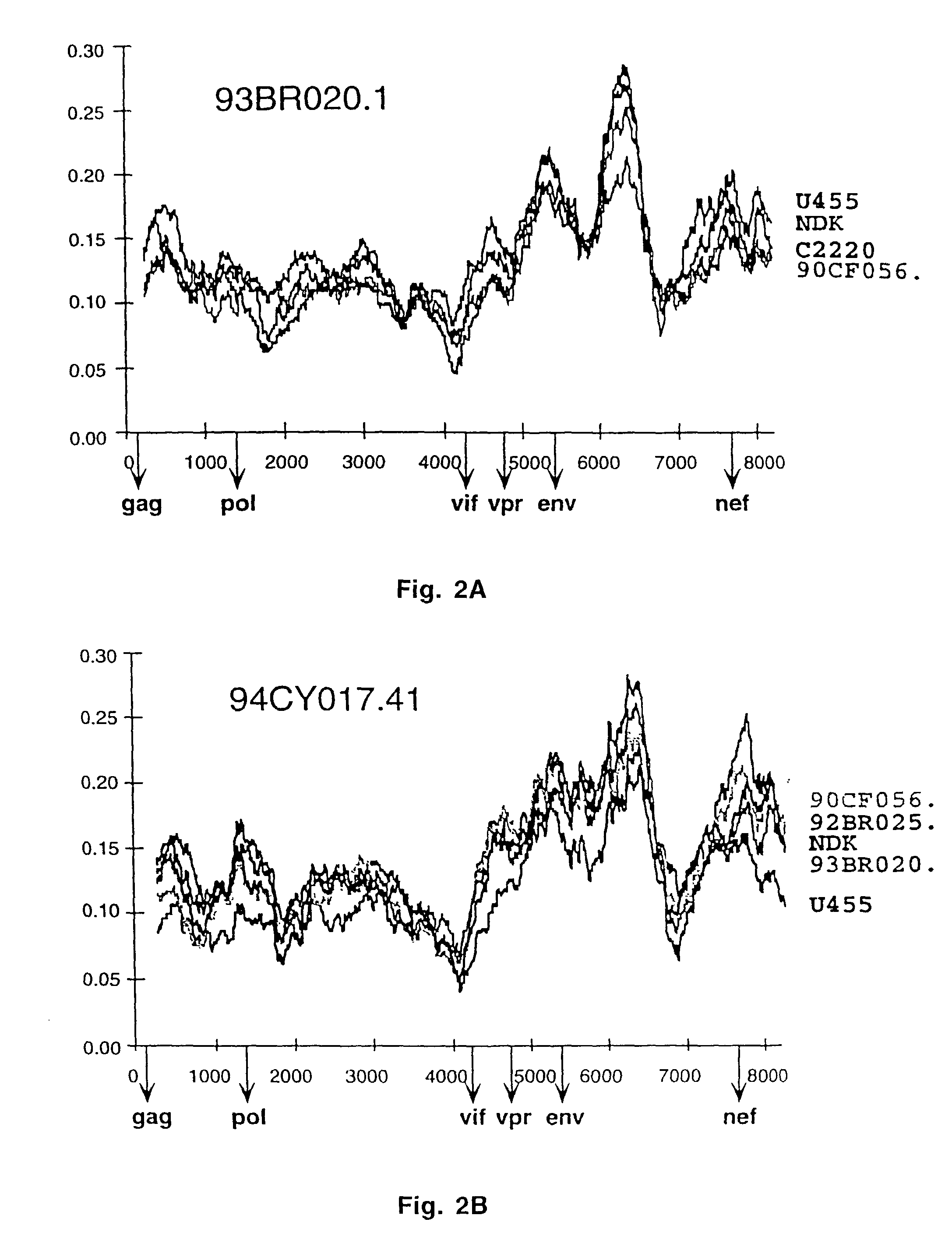Reference clones and sequences for non-subtype B isolates of human immunodeficiency virus type 1
a human immunodeficiency virus, non-subtype b technology, applied in the direction of viruses, peptide/protein ingredients, cleaning compositions, etc., can solve the problems of subtype specific differences in virus biology, largely unknown immunogenic and biological properties, etc., to reduce the level of infection, attenuate any dysfunction, and enhance the immune response
- Summary
- Abstract
- Description
- Claims
- Application Information
AI Technical Summary
Benefits of technology
Problems solved by technology
Method used
Image
Examples
example 2
[0171] Identification of Non-Subtype B HIV-1 Viruses
[0172] Molecular Cloning of Non-Subtype B HIV-1 Isolates
[0173] Of the geographically diverse HIV-1 isolates described herein, five had previously been classified as members of (group M) subtypes A (92RW009), F (92BR020, 92BR029), and G (92NG003, 92NG083) on the basis of env (17,19) and / or gag sequences (1). One (90CF056) was chosen because it originated from a major epicenter of the African AIDS epidemic. In addition, 90CF056 did not fall into any known subtype at the time of its first genetic characterization (43). Isolates from Zambia (96ZM651 and 96ZM75 1) and India (94IN476) were chosen because of the known subtype C prevalence in those countries. The two isolates from Cyprus (94CY017 and 94CY032) were selected because of the extensive diversity of HIV-1 in the drug user population (29). Table 1 summarizes available demographic and clinical information, as well as biological data concerning the isolate phenotype (SI / NSI). Only ...
example 3
[0177] Phylogenetic Analyses in Gag and Env Regions
[0178] To determine the phylogenetic relationships of the viruses described herein, evolutionary trees from full length gag and env sequences were first constructed. This was done to confirm the authenticity of previously characterized strains, classify the new viruses, and compare viral branching orders in trees from two genomic regions. The results confirmed a broad subtype representation among the selected viruses (FIGS. 1A-1B). Strains fell into six of the seven major (non-B) clades, including three for which full length sequences are not available (i.e., F, G and H). However, comparison of the gag and env topologies also identified three strains with discordant branching orders. 92RW009.6 grouped with subtype C viruses in gag, but with subtype A viruses in env. Similarly, 93BR029.4 clustered with subtype B viruses in gag, but with subtype F viruses in env. 94CY017.41 appeared to cluster within subtype A viruses in env, but fell...
example 4
[0179] Diversity Plots
[0180] To characterize the putative recombinants as well as the other strains in regions outside gag and env, pairwise sequence comparisons with available full length sequences from the database were performed. A multiple genome alignment was generated which included the new sequences as well as U455 (subtype A), LAI, RF, OYI, MN and SF2 (subtype B), C2220 (subtype C), ELI, NDK and Z2Z6 (subtype D), and 90CF402.1, 93TH253.3 and CM240 ("subtype E"). The percent nucleotide sequence diversity between sequence pairs was then calculated for a window of 500 bp moved in steps of 10 bp along the alignment. Importantly, distance values were calculated only after all sites with a gap in any of the sequences were removed from the alignment. This ensured that all comparisons were made across the same sites.
[0181] FIGS. 2A-2J depict selected distance plots for the newly characterized viruses. For example in FIG. 2A, 93BR020.1 (putative subtype F) is compared to U455 (subtyp...
PUM
| Property | Measurement | Unit |
|---|---|---|
| nucleic acid | aaaaa | aaaaa |
| nucleic acid sequences | aaaaa | aaaaa |
| length | aaaaa | aaaaa |
Abstract
Description
Claims
Application Information
 Login to View More
Login to View More - R&D
- Intellectual Property
- Life Sciences
- Materials
- Tech Scout
- Unparalleled Data Quality
- Higher Quality Content
- 60% Fewer Hallucinations
Browse by: Latest US Patents, China's latest patents, Technical Efficacy Thesaurus, Application Domain, Technology Topic, Popular Technical Reports.
© 2025 PatSnap. All rights reserved.Legal|Privacy policy|Modern Slavery Act Transparency Statement|Sitemap|About US| Contact US: help@patsnap.com



